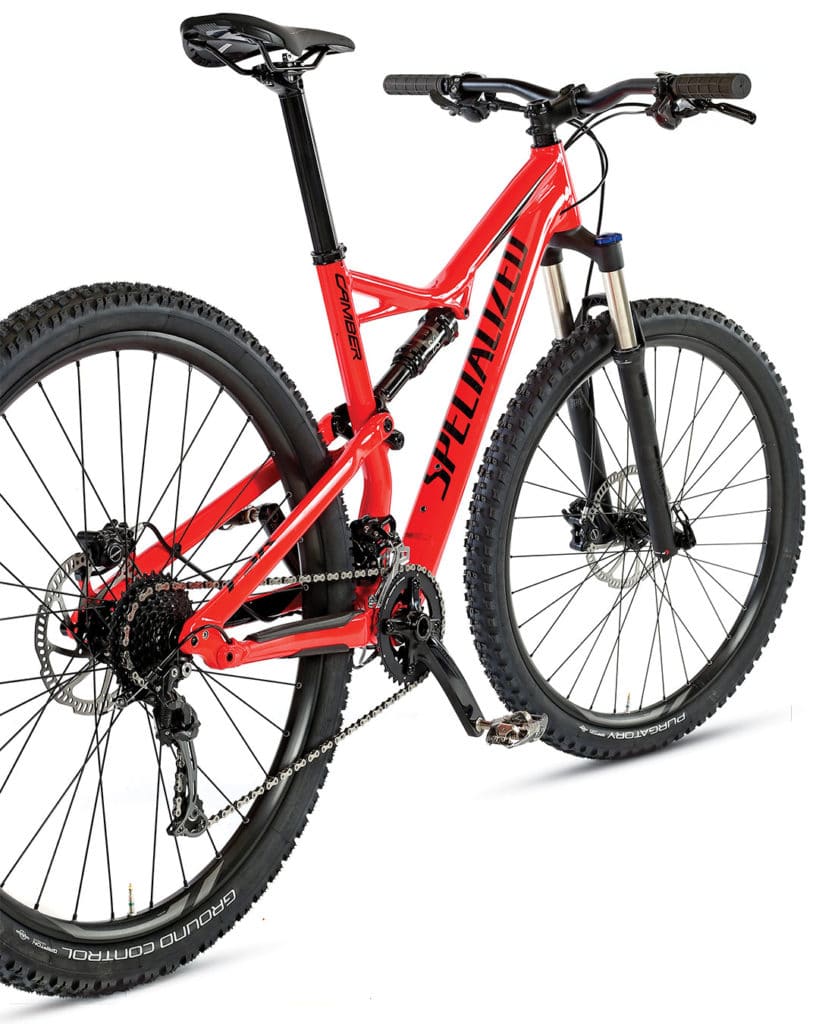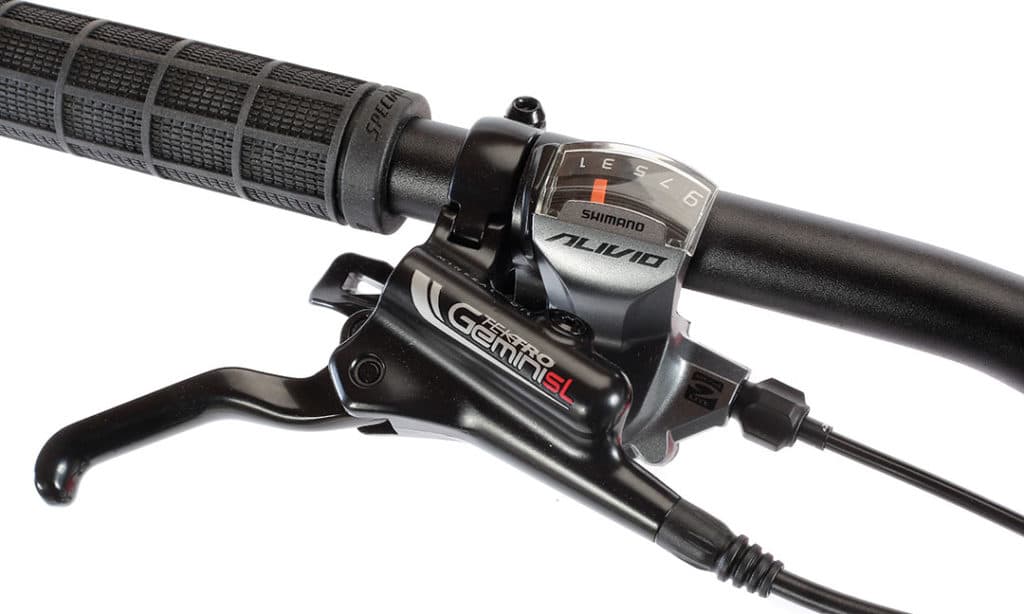Review – Specialized Camber 29
Sub $2,000 full suspension ready to rip

Unless you’ve been living under a rock, you know that Specialized loves to build mountain bikes. Specialized is best known for its iconic Stumpjumper and Rockhopper models, but those are far from the only bikes with the big red S logo out on the trail. In fact, Specialized’s lineup is so complete that if you can’t find a bike that fits your riding style, you’re being too picky. Specialized makes bikes for everything from downhill to cross-country. The Specialized Camber 29 line falls comfortably in the middle of those categories, with just enough travel to conquer technical trails but not so much that it hinders pedaling efficiency. You could argue that of all of Specialized’s offerings, the Camber is the truest mountain bike of them all, with versatility that makes it capable of riding all over the mountain.
WHO IS IT MADE FOR?
The Specialzied Camber 29 is designed to excel at XC, trail and all-mountain riding. In fact, it is so versatile that we’d be hard-pressed to put this bike into just one category. The Camber could handle XC or endurance racing, as well as some of the gnarlier trails encountered on big backcountry rides.

WHAT IS IT MADE FROM?
There are several versions of the Camber to satisfy any price point or wheel size preference. Our test bike comes with an aluminum frame with 120 millimeters of travel via Specialized’s FSR design. The bike is also available with carbon construction, and there are also options designed around 27.5-inch wheels. With a tapered head tube, 12×142-millimeter rear-axle spacing and suspension that rides on bearings throughout, the Camber offers handling on par with bikes twice its cost and with either more or less travel. The Specialized Camber 29 can be had for a reasonable price but delivers performance that belies its modest cost.

WHICH COMPONENTS STAND OUT?
The frame is the standout here. While the components are adequate, they are nothing to write home about; however, this is a chassis that will be worth upgrading for years to come. The aluminum build comes with Specialized’s own FSR suspension platform and the same geometry as the top-level S-Works Camber. It’s a chassis that will still be ready to roll for many years, even long after the entry-level shifters and brakes wear out. Specialized knows the value of nice tires; they can make or break a bike’s ride quality, especially at this relatively low price point. Skimping on tires can make an otherwise nice bike feel heavy and sluggish with poor traction. Thankfully, Specialized specs its excellent Purgatory and Ground Control tires. These tires are relatively lightweight, quick-rolling and tubeless-ready. This was one component we did not feel the need to replace out of the gate.

HOW DOES IT PERFORM?
Setup: Setup is made easy thanks to the single air valve on both the fork and shock. While this version of the Camber does not come with the patented Specialized AutoSag feature, it is still very easy to set the shock to 25-percent sag and the fork to 20 percent.

Moving out: The 29er version of the Camber is essentially identical to the 27.5-inch version and sports the same wheelbase, chainstay length and even top tube length. Standover may be slightly higher, depending on tire choice, but it was adequate for all of our test riders right out of the box. The bike comes with a handlebar that matches the bike well, with a wide but not too wide 750-millimeter width.
Pedaling: The Camber might not be the cross-country rocket that the better-known Epic is; however, this bike is built to earn the descents as an efficient pedaler. The Camber does not come with Specialized’s proprietary Brain technology and instead relies on a more conventional shock for its pedaling platform. The X-Fusion shock comes with a lockout switch, although we didn’t feel the need to use it. For paved climbs or fire roads, it may be a nice feature, but the Camber pedals well without it.

Climbing: The Camber feels relatively efficient, but it takes a little extra effort to spin those big hoops uphill. The 29er wheels have no problem maintaining momentum over rocky terrain when pointed uphill, but charging at short and punchy climbs is not how this bike likes to ascend. Instead, we had the best luck choosing a low gear and simply spinning steadily uphill. With this technique, the Camber can claw its way up nearly anything. Cornering: With a relatively nimble geometry, complete with a short stem and relatively short chainstay, the Camber handles well through corners. It actually feels slightly more stable than many of the other Specialized bikes we’ve tested, including the Epic and Stumpjumper models. The Camber is quick and nimble enough without being twitchy.
Descending: The Camber is a solid bike, and while the short suspension travel limits its descending capabilities somewhat, it’s more than adequate for most trail situations. We’d be apprehensive about taking it down our steepest test trails, but the relatively stable handling combined with active and effective suspension make for a bike that’s not afraid to take the tough route down from time to time.

TRICKS, UPGRADES OR TIPS?
The Camber is ripe for some upgrades, but that’s not to say that the bike isn’t ready to ride right out of the box. Don’t get us wrong; this bike works very well in bone-stock trim; however, a few hundred dollars’ worth of upgrades will go a long way towards boosting its performance. First, the Camber needs a dropper post. Fortunately, the frame comes complete with routing for either an internally or externally routed post. Get one. Second, the nine-speed shifting is slow and somewhat clunky. The bike comes with a Deore rear derailleur, so we’d recommend upgrading the cassette and shifters to a 10-speed setup to match. The Camber ships with tubes installed, but we recommend going tubeless right out of the gate. A conversion kit, such as Stan’s or something similar, will run about $50 plus installation. It will be worth every penny. The Tektro Gemini brakes have a very firm lever feel and plenty of modulation. For aggressive or big riders, though, they may not deliver enough power. You could swap the stock resin pads for some aftermarket metal ones or upgrade to a different brake altogether if these stoppers are not powerful enough for you. Finally, be sure to work a pair of pedals into your budget, because like most serious trailbikes, the Camber does not come with any.

BUYING ADVICE
The Camber is one of the few full-suspension bikes under $2000 that we can truly recommend. While it’s not without a few compromises in the component department to achieve its sweet price point, there is nothing on this bike that won’t work absolutely fine right out of the box. With a few upgrades as parts wear out, the Camber will only get better with age. The tried-and-true suspension platform is built into a truly capable and versatile frame that you will enjoy for years to come.




